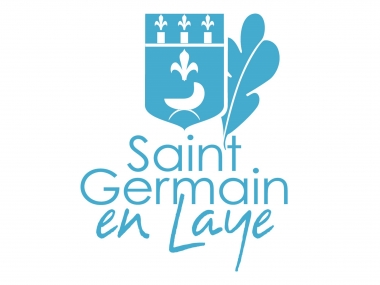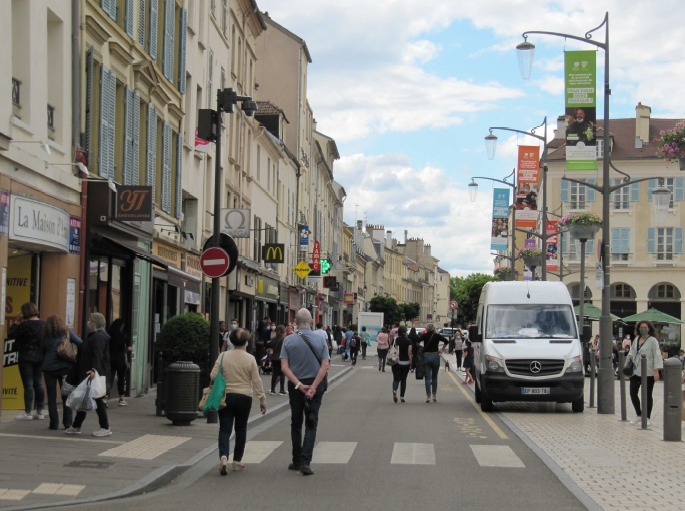How to work with public space in an integrated approach to the city context - the case of Saint-Germain-en-Laye
Edited on
22 August 2022Saint-Germain-en-Laye is a prosperous municipality located 20 km West of Paris. Formal royal residence, it benefits from rich built cultural heritage, extensive green areas and an international community. It counts 45 000 residents year-round, but hosts a crowd of 4.5 million people in transit yearly.

Saint-Germain is well connected to Paris by RER A , and easily accessible by road. A network of bicycle paths has been developed while the pedestrian area of the downtown has been gradually extended. The car parking offer in the hyper-centre is mainly underground (320 places on-street, 2000 places underground) and there are also free places for bikes and motorcycles. However, besides the heavy transit traffic and the commercial deliveries encountered elsewhere in the Parisian metropolis, the city is confronted with specific difficulties like a national road cutting it in two and the localisation of the end station of RER A (20000 people daily) in its very centre with cars and buses generating traffic jams at rush hours. To the North of the municipality, the Saint-Germain forest takes up about 80 % of its administrative territory. Tourists, hikers and transit travellers therefore shape the use of public space just as much as residents.
Challenges
The main challenges of Saint Germain pertain to the traffic flow coming from the Paris area and neighbouring cities, travelling through town, and the resulting traffic congestion in most of the downtown area, despite its historical significance and fragility. This is also related to the new public transit infrastructure and the need to rethink the way people travel through the city.
Secondly, the local mindset pertaining to personal use cars and parking is also an important factor and at the same time a key factor to rededicating public space use for greening, shared use, bike lanes, playgrounds, commerce. Furthermore, at the beginning there was a strong opposition of some of the shop keepers regarding the extension of the pedestrian area and the reduction of the number of on street parking spaces with the redistribution of the public space.
The Integrated Action Plan was carried out by the municipality of Saint-Germain-en-Laye with the help of an Urbact Local Group made up of inhabitants, town hall personnel and elected officials, and especially created in the frame of Space4People. The local representatives are all members of local Committees, originally set up by the City. Creating the Urbact Local Group was part of the Urbact process, but it was based on the already existing structures and approaches as part of the public consultation process.
For this reason, the composition of the ULG was rather easily defined. However, the effective set up took more time for local committees to designate their representatives and the sessions were a challenge to mediate. One of the reasons for this was the lack of legitimacy that some of the ULG members felt, representing the local population. The ULG members also did not all have similar work schedules, and were not all available at the same time. Finally, tools used in Urbact sessions were harder to utilise during the ULG sessions, as members preferred to have a free-flowing conversation, rather than a structured workshop.
Pertaining to the IAP, one of the major challenges was to encourage members to ‘think big’ or think more long term, with a more holistic approach to actions and policy ideas. However, the outcome of the IAP is fitting for the city’s organisation, as it acts as an open list of feasible and attractive ideas from the community that intersect with ongoing or future city projects.
Another important challenge was represented by the temporality of the political agenda and ongoing studies and projects that did not fit with the ambitions and length of the work done in the URBACT project. For example, there is a circulation and parking management study, one regarding the reconfiguration of the Castle intermodal hub and a Climate and Energy plan that are being produced now and this work could not be effectively integrated with and used for the IAP since the beginning as they were not finalised yet.
Objectives
To address the main challenges listed earlier, the IAP plays a key role, as a part of an ongoing Climate and Energy Plan in which it will be integrated. Furthermore, it will be further adapted depending on the results and updates from different related studies and projects. The IAP brings forward a set of specific, localised and pre-validated ideas (bottom-up) supporting a more holistic view on the city challenges (top-down).
As the ULG is a part of the IAP process and a helpful tool in policy-making for the city, it is set to become a permanent Committee, much like the ones Saint-Germain-en-Laye already frequently consults. By keeping the sessions regular, but at a less frequent rhythm, it enables the ULG members to stay invested whilst being more accommodating to their work schedules.
From the methodological point of view, the use of small scale actions and temporary tests proved to be very beneficial and is planned to become a current practice. Some other approaches like the association of the opponents and the use of peers’ power in the negotiations with the most virulent ones are also considered for the future. Furthermore, the URBACT method and tools guided the public consultation processes initiated by Saint Germain as well as the development of further projects.

In action
In the frame of the Space4People, Saint Germain considered all the 3 major themes of the network in an integrated way and naturally interconnected due to their unavoidable interdependencies. However, the focus remained on the first one (pedestrian and semipedestrian spaces), treated as a transverse topic. Coherently, the SSA implemented concerned the extension of the downtown pedestrian area. The pandemic offered the opportunity of a reinvented public space open to the people after the first lockdown in France. Many temporal and physical organisations were tested, while the freed up public space was used for urban and commercial activities and redecorated with plants and urban furniture.
Several formal and informal surveys were done in order to assess people’s (inhabitants and regular visitors from the nearby area) preferences and build together the final solutions. This work was supported as well by a further European project (Safely Connected EIT UM project) conceived based on the first URBACT insights. The process took shorter time than initially planned and could be also anticipated due to the particular pandemic’s situation. Furthermore, it helped the obtention of additional European funds for the works for the definitive reconfiguration of some street sectors rendered pedestrian.
Additionally, the extension of the pedestrian area and the overall redistribution of public space, were thought in an integrated manner not only in relation with the parking management, but also with urban logistics (deliveries and other services for business keepers in the respective areas).
Also, several related studies and processes were started in parallel in order to substantiate and guide measures discussed in the ULG and planned to be included in the IAP. To ensure the formal approval of the IAP by the City Council, the elected representatives were periodically informed on the project and its advancements and the ones directly in charge of the urban mobility, public space, active travel etc, were included in the IAP with a double role, to inform it at political level and to better communicate and explain it among their peers and facilitate its understanding and acceptance / appropriation.
If in a first phase the association of the main opponents (in this case business keepers) in the processes, seemed to work, on a longer term their collaboration proved to be quite limited also because of the reduced time and effective understanding of the project that prevented genuine collaborative approaches and processes to reach their maturity.

Conclusions
The participation in the Space4People network inspired and oriented the ongoing and planned participatory planning process. The use of adversities as opportunities proved a very successful approach. The local activities taken into this context demonstrated the value and role of small scale (temporary) actions with test value. Making use of formal surveys (possibly complemented by informal data) to collect and share data and thus provide facts proved valuable as well.
The URBACT tools were perceived as sophisticated and rather difficult to adopt by the ULG who had a strong orientation towards more classical “old style” approaches. Additionally, it proved difficult to maintain political support on a long run.
It was essential to employ a narrative to gain supporters, including the political level, to focus on mutually agreed objectives and vision. As was taking a small step approach with enough time at hand to realise structural changes by listening to stakeholders and collaboratively work with them.
Submitted by Claus Kollinger on
